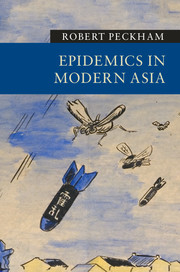Introduction: Contagious histories
Published online by Cambridge University Press: 05 May 2016
Summary
Throughout 2014, an epidemic of Ebola virus disease (EVD) in West Africa dominated the global media. While the World Health Organization (WHO) declared the epidemic a public health emergency, images of makeshift quarantines, field-laboratories, and bagged bodies fueled panic in many countries around the world. The high mortality rate of up to 90 percent, together with graphic details of the symptoms, which may include internal and external bleeding, added to public concerns. In Hong Kong, health authorities stepped up surveillance and rushed to implement Ebola contingency plans. Travelers from West Africa who showed symptoms of fever were quarantined and tested. Authorities in the People's Republic of China (PRC), conscious of the large numbers of Chinese workers in Africa, heightened border controls.
Two other viral infections also caused alarm across Asia. Middle East respiratory syndrome (MERS), a highly pathogenic viral illness, was first reported in 2012 in Saudi Arabia. The Saudi Arabian economy is dependent on some nine million non-national residents, many of them migrant workers from South and Southeast Asia. Every year millions of pilgrims from across Asia converge on Saudi Arabia for the hajj, the annual Islamic pilgrimage to Mecca. In May 2015, an outbreak of MERS in South Korea led to the imposition of quarantine measures, the closing of schools, and – amidst public panic – the establishment of specialist MERS clinics in major cities. By mid July 2015, there had been 186 confirmed cases of infection with 36 deaths (Figure 0.1).
Meanwhile, in March 2013, human cases of the novel avian influenza virus H7N9 were reported in China. A WHO announcement about the new virus, which was posted on Twitter, prompted up to 500 retweets per hour. By December 2013, there had been 143 laboratory-confirmed human cases of H7N9 with 45 deaths. A 36-year-old Indonesian domestic helper, who had visited a live poultry market and slaughtered a chicken across the border in Shenzhen, became the first confirmed H7N9 patient in Hong Kong. This sparked a ban on poultry imports from Shenzhen farms and a heightened alert in hospitals.
- Type
- Chapter
- Information
- Epidemics in Modern Asia , pp. 1 - 43Publisher: Cambridge University PressPrint publication year: 2016



